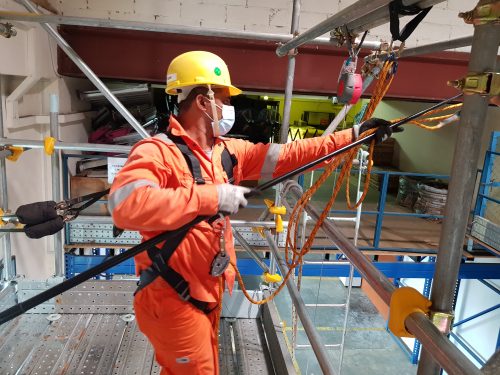News | Mirador Building Contractor
NEWS
Training : RESCUE AFTER A FALL
RESCUE AFTER A FALL

Do you know that ‘Falls from Height’ (FFH) is the largest contributor to workplace deaths in Singapore in recent years? This is according to reports by the Ministry of Manpower.
Performing work at high elevations is one of the risks exposed by our employees in their daily work activities. As an Approved Scaffold Contractor (ASC), our teams of scaffold erectors are at a higher risk of falling from height during their course of work. Other than ensuring proper risk assessments and appropriate control measures are in place, our employees also need to know how to respond to falling from height situations. During an emergency situation, the respond time and the ability to execute the rescue are vital in rescuing the victim. One example of such emergency situations is performing rescue after a victim had fallen and suspended at height.
Our emergency response team members are sent for ‘Rescue After A Fall’ training conducted by Approved Training Organisation. Rescue members are then required to attend an internal ‘Rescue After A Fall’ training conducted by the HSE Department every quarter. The internal training consists of both theory and practical. The key steps to performing the Rescue after a fall are as follows:

1. Victim fell and suspended at heights.

2.Rescuer responded with the rescue kit.

3.Rescuer securing the rescue kit onto scaffold to prevent equipment falling from height

4.Securing the rescue sling onto the anchorage point.

5.Securing the double pulley (blue) onto the anchorage point (high anchorage rescue).

6.Securing the rope controller (GRIGIRI) onto the front D ring of the rescuer’s harness.

7.Measuring the length required for the rescuer kit to reach the back D ring of victim.

8.Take out the telescopic pole from the equipment bag and connect the rescue attachment (Gotcha frog) to the telescopic pole.

9.Ensure rescue attachment (Gotcha frog) in open position by pressing on both side of the levers.

10.Reach for the back D ring of the victim and attach the rescue attachment (Gotcha frog) onto the back D ring, before putting the telescopic pole at the side.

11.Tension the rescue rope with the rope controller (GRIGRI).

12.By using the body weight of the rescuer, raise the victim slightly to release the tension on his safety harness.

13.Release the snap hooks from the anchorage and secure the snap hooks onto the rescue rope.

14.Slowly lower the victim by releasing the rope controller.

15.Upon reaching the ground level, the victim will be placed in recovery position to prevent ‘Reflow Syndrome’.
The regular internal training allows the rescuers to be familiar with the rescue procedure, and builds up their self-confidence when required to perform the rescue during emergencies. At the end of the training session, each rescuer is tested and assessed individually, ensuring that all rescuers are competent to carry out the emergency rescue.
We hope never to be in situations where our rescue teams are called into action, however they are ready to respond and rescue when the need arises.

“The quarterly internal ‘Rescue after a fall’ training provides an opportunity for us to practice what we had learnt previously and build up our confident level when we are required to perform the rescue of a victim suspended at height.”
MAJAHARUL, Scaffold Erector & Emergency Response Rescuer.







